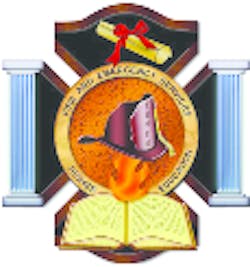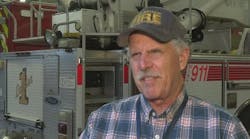When Jennifer Henson began looking in to the Fire and Emergency Services Higher Education (FESHE) recognition process, the director of Fire Protection Technology and Firefighter Certification at Catawba Valley Community College in North Carolina, wanted to make sure it would be a good fit for her program, its students and other stakeholders. This needs assessment took her a full year, she says. But her work was far from over.
“Then it took me the eight months to work with my instructors to change our objectives and learning outcome to mirror those recommended by FESHE,” Henson says. “I have wonderful instructors and college administrators who were very supportive and helped the process run smoothly. Once this was complete and the application was sent to the National Fire Academy, I was notified a month later that we had been approved by NFA for FESHE (recognition) and they would send it to the North Carolina Office of State Fire Marshal for approval. This process only took a day. I have spoken with other colleges who are still in the process and it has taken them longer.”
“Win-win situation”
Launched some six years ago, the FESHE recognition program, provides a model curriculum colleges and universities can adopt as their own. To date, some 80 institutions nationwide have been recognized.
“The FESHE standardized courses provide a win-win situation for the student, the institution and our industry as a whole,” says Ken Farmer, Section Chief, Education, Training and Partnerships Section at the National Fire Academy (NFA) in Emmitsburg, MD.
“The program provides a seamless articulation among peer institutions and between two-year and four-year schools,” Farmer explains. “The core competencies are the same from institution to institution. The level of accomplishment expected of the student is rigorous and identical across the nation. Standardizing the curriculum works to the advantage of prospective employers (because) they will know that FESHE-trained applicants come to them with the basic body of knowledge supported by the USFA (U.S. Fire Administration), NFPA (National Fire Protection Association) and designators such as the Center for Public Safety Excellence (CPSE). Both NFPA and CPSE have approved the National Professional Development Matrix, which is the roadmap for cross-walking experience, education and training.”
Students have an added benefit – a certificate for each course, which can be used outside of a degree curriculum.
“Once a student has successfully completed a FESHE standardized course, they may apply for a NFA certificate. Doing so establishes a NFA transcript for the student as well as proving course competency. NFA certificates assist the student seeking a fire career and those, already on the job, looking to promote,” Farmer says. “These are the standards that hiring and promoting authorities are currently expecting. Employers expect credible experience and education levels. The FESHE recognition program provides a high level of integrity. This level is transferred to the school which makes the FESHE recognized fire science or EMS management program attractive to prospective students.”
Higher education institutions seeking FESHE recognition are required to meet a six-course model fire science curriculum for their associates program. Students completing each of the model courses receive a National Fire Certificate of Completion, and as Farmer points out, this certificate becomes a portable transcript that certifies a student’s completion in the core course. For example, if an Alaska-based student receives a certificate for Building Construction for Fire Prevention, then moves to a Florida college, the certificate ensures the student will not need to repeat the course.
Although logic might dictate this arrangement of reciprocity be automatic, colleges and universities can be illogical bureaucracies. The recognition program guarantees the course standard has been met.
Recognition requirements
Institutions seeking recognition should offer NFA’s six-course model curriculum for the associate’s-level degree. These six core courses, with ubiquitous federal abbreviations, are:
- Building Construction for Fire Protection (BCFP)
- Fire Protection Systems (FPS)
- Fire Behavior and Combustion (FBC)
- Fire Prevention (FP)
- Principles of Emergency Services (PES)
- Fire Protection Hydraulics and Water Supply (FPHWS)
The FESHE baccalaureate program consists of 15-upper division courses.
Recognized institutions offering recognized degrees can be found at http://www.usfa.fema.gov/training/prodev/feshe_recognition.html.
All courses must be offered for academic credit. Non-credit courses do not qualify for NFA recognition or certificates. Although the titles of these courses can vary from institution to institution, the NFA encourages the use of its standardized titles. Institutions are required to meet student course reporting completion records.
More about the requirements can be found at http://www.usfa.fema.gov/training/prodev/feshe_recognition.html
Colleges’ perspective
Despite the lengthy process, Cataba’s Henson has seen many benefits to becoming a FESHE-recognized school.
“The FESHE recognition has helped with student recruitment, and enrollment greatly increased during the fall semester after FESHE recognition was achieved,” Henson says. “Our students and employers know our program has met the standards of excellence established by FESHE professional development committees and the National Fire Academy. Our students receive the benefit of not only receiving academic credit at CVCC for their FESHE-approved class, but also receiving NFA credit for the course, which I feel encourages student retention.”
Randy Souther, director of Fire Science and EMS-MA programs at Aims Community College in Colorado, found the process of recognition seamless and the benefits valuable. “The process was very easy since the Colorado Community College System adopted the FESHE model curriculum a couple of years ago,” he says. “Last fall was our first semester so we are really just getting started. The students certainly appreciate the fact that we are aligned with the National Fire Academy and it adds further credibility to the program. Our Fire Science A.A.S. degree is also accredited by IFSAC (International Fire Service Accreditation Congress) and adopting the FESHE model also helps with meeting some of the accreditation criteria.”
Jim Jollie, fire programs manager at Seminole State College in Florida, had some special state-mandated considerations to put the FESHE model to work.
“When I started the job as the degree program manager, the groundwork was laid to support a relatively painless transition to the FESHE model,” Jollie says. “While the process was not overly difficult, the obvious challenge was aligning our outcomes to match both the FESHE-required course outcomes along with the requirements of our regulatory agency, Florida Bureau of Fire Standards and Training. This process took over two years, primarily due to the curriculum change process both internally and with external regulatory agencies. This process has also provided me with a network of fire educators both regionally and nationally who are committed to a common goal: improving firefighter education and reducing fire deaths.”
For institutions teaching fire and EMS, Jollie makes a reasoned argument for adopting FESHE.
“I would suggest other colleges follow suit,” Jollie says. “The main reason is the hard work has already been done on a national level. My first question I would pose to anyone wanting to go a different route would be, ‘Why would you try to circumvent the research done through the National Fire Academy only to re-work a new fire science program with different outcomes?’ While additional learning outcomes may be required based on regional needs; training for topography, weather events or population demands, the basic core outcomes remain the same. FESHE courses like Fire Behavior, Occupational Safety and Building Construction will have the same outcomes regardless of delivery model or location. Regional spins can be simply added based on the needs of the community.”
Stuart Bishop, director of Public Safety Education at Northland Pioneer College in Arizona, says, “I think the FESHE recognition raised the bar for our fire science program as it validated our program to a national level. I know our end users (fire departments) appreciate the fact their firefighters (students) were able to obtain National Fire Academy classes. We also run a High School Vocational Fire Science program and the students take a few of the core classes, which also enables them to have a few more certificate classes under their belt as they get out of school and begin applying for a job in the fire service.”
Making the transition
If institutions need convincing to follow the FESHE curriculum, NFA’s Farmer offers to provide help and as much latitude possible to get the job done.
“At the NFA we take pride in helping institutions provide the very best customer service to their students,” Farmer says. “We will assist schools as they move through the recognition process. Many schools must re-focus the student learning outcomes of their existing courses to match those in the FESHE standardized criteria. FESHE does not require course code or course title changes, although standardizing course names would be a major benefit. However, we do require strict adherence to the competency and outcomes expected of each course.”
Farmer adds, “NFA staff will make sure that all requirements for recognition are met before seeking concurrence from the school’s state fire training director. This will help expedite the overall approval process. We are available via email and telephone to coach program directors through the process as needed. Our goal is to help schools secure the high standards set by the FESHE curriculum development committees.”
Steps for Institution Recognition
Step #1
College sends NFA a completed “Request for Recognition”
Step #2
NFA forwards “Request for Recognition” to National Fire Science Degree Program Committee (Associate’s or Bachelor’s) for concurrence
Step #3
NFA sends “Request for Recognition” to state fire training director for concurrence
Step #4
NFA issues Recognition Certificate






